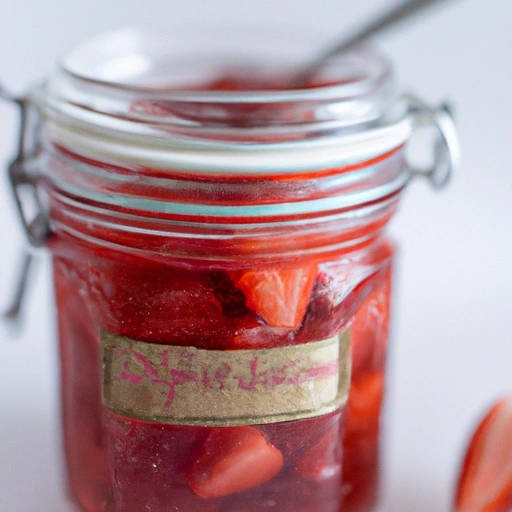Strawberry Preserve
Description

Strawberry preserve is a delicious and versatile food ingredient made from whole or cut strawberries, sugar, and sometimes pectin, which acts as a gelling agent. The mixture is cooked down to a thick consistency that spreads easily and has a balance of sweet and tangy flavors. Strawberry preserve retains the fruit's natural color, aroma, and chunks of fruit, making it a delightful addition to various recipes. The measure of strawberry preserve in recipes can vary, but common measures include cups (American), grams (European), and ounces (American).
Common uses
Strawberry preserve is commonly used as a spread for bread, toast, and pastries. It is also used as a filling for cakes, doughnuts, and sandwiches, as well as a topping for ice cream, yogurt, and pancakes. Additionally, it can be used as a glaze for meats or as an ingredient in salad dressings and sauces, adding a sweet and fruity flavor to a variety of dishes.
Nutritional value
Calories
A typical serving of strawberry preserve, which is about 1 tablespoon (20g), contains approximately 50-60 calories.
Protein
Strawberry preserves contain a negligible amount of protein, typically less than 0.1 grams per tablespoon (20g).
Fat
Strawberry preserves are virtually fat-free, with less than 0.1 grams per tablespoon (20g).
Carbohydrates
Strawberry preserves are high in carbohydrates, with about 13-15 grams per tablespoon (20g), most of which come from sugars.
Vitamins
While cooking may reduce their vitamin content, strawberry preserves can still contain some vitamin C, provided by the strawberries.
Minerals
Strawberry preserves may contain small amounts of minerals such as potassium and manganese, which are naturally present in strawberries.
Health benefits
Strawberry preserves contain vitamin C and antioxidants from the strawberries, which may contribute to immune system health and the reduction of oxidative stress. The fiber in the fruit can aid in digestion, although preserves typically contain less fiber than fresh fruit due to the cooking process.
Potential risks
Strawberry preserves are high in sugar, which can contribute to weight gain if consumed in large amounts. Individuals with diabetes or those watching their sugar intake should consume strawberry preserves in moderation. Additionally, commercially prepared preserves may contain additives and preservatives that some people may wish to avoid.
Common recipes
Strawberry preserves can be used in various recipes, such as strawberry jam tarts, thumbprint cookies, and peanut butter and jelly sandwiches. They're also a common filling in crepes and Swiss rolls.
Cooking methods
While strawberry preserves are typically used as is, they can also be incorporated into recipes where they are heated and melt slightly, such as in sauces or as a topping for warm desserts.
Pairing with other ingredients
Strawberry preserve pairs well with a variety of flavors including vanilla, chocolate, lemon, and balsamic vinegar. It also complements dairy products like cream cheese and whipped cream, as well as nut butters.
Summary
Strawberry preserve is a sweet and tangy concoction made from strawberries and sugar, often enriched with pectin. With its vibrant color and chunky texture, it adds both flavor and visual appeal to a wide range of dishes. While it has some nutritional benefits, its high sugar content means it should be enjoyed in moderation. Strawberry preserve is a universal ingredient, with applications ranging from simple spreads to complex sauces and desserts, making it a pantry essential in cuisines around the world.